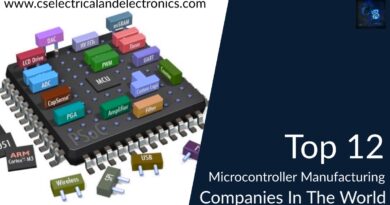MCQ On Silicon Controlled Rectifier (SCR)
Hello Guys, welcome back to my blog. In this article, I will discuss MCQ on silicon controlled rectifier (SCR), the objective type questions related to silicon controlled rectifier.
If you want an article on some other topics then comment us below in the comment section. You can also catch me @ Instagram – Chetan Shidling.
Also read – Power Electronics Questions And Answer.
MCQ On Silicon Controlled Rectifier
01. The Silicon Controlled Rectifier has …………….. how many PN junctions
- 1. Two
- 2. Three
- 3. Four
- 4. None of the above
ANS: 2
02. The Silicon Controlled Rectifier is the solid-state equivalent of …………….?
- 1. Triode
- 2. Pentode
- 3. Gas-filled triode
- 4. Tetrode
ANS : 3
03. Silicon Controlled Rectifier has how many ………….. semiconductor layers
- 1. Two
- 2. Three
- 3. Four
- 4. None of the above
ANS : 3
04. Silicon Controlled Rectifier has three terminals, namely ……………
- 1. Cathode, anode, gate
- 2. Anode, cathode, grid
- 3. Anode, cathode, drain
- 4. None of the above
ANS: 1
05. Silicon Controlled Rectifier behaves as ……………. switch
- 1. A Unidirectional
- 2. A Bidirectional
- 3. A Mechanical
- 4. None of the above
ANS: 1
06. Silicon Controlled Rectifier is also called as …………
- 1. Triac
- 2. Diac
- 3. Unijunction transistor
- 4. Thyristor
ANS: 4
07. Silicon Controlled Rectifier is made up of ………….
- 1. Germanium
- 2. Silicon
- 3. Carbon
- 4. None of the above
ANS: 2
08. In the operation of a Silicon Controlled Rectifier, the anode is …………… w.r.t. cathode
- 1. At zero potential
- 2. Negative
- 3. Positive
- 4. None of the above
ANS : 3
09. In the normal operation of a Silicon Controlled Rectifier, the gate is ………..w.r.t. cathode
- 1. Positive
- 2. Negative
- 3. At zero potential
- 4. None of the above
ANS: 1
10. Silicon Controlled Rectifier combines the features of ………….. \
- 1. A rectifier and resistance
- 2. A rectifier and transistor
- 3. A rectifier and capacitor
- 4. None of the above
ANS: 2
11. A control element of a Silicon Controlled Rectifier is ………….
- 1. Cathode
- 2. Anode
- 3. Anode supply
- 4. Gate
ANS: 4
12. The normal way to turn on a Silicon Controlled Rectifier is by the ……………..
- 1. Breakover voltage
- 2. Appropriate anode current
- 3. Appropriate gate current
- 4. None of the above
ANS : 3
13. Silicon Controlled Rectifier can be turned off by …………….
- 1. Reducing anode voltage to zero
- 2. Reducing gate voltage to zero
- 3. Reverse biasing the gate
- 4. None of the above
ANS: 1
14. Silicon Controlled Rectifier is ……………….. triggered device
- 1. Voltage
- 2. Current
- 3. Voltage as well as current
- 4. None of the above
ANS: 2
15. In Silicon Controlled Rectifier circuit the supply voltage is ……….. that of a break over voltage
- a. Equal to
- b. Less than
- c. Greater than
- d. None of the above
ANS: b
16. When the Silicon Controlled Rectifier is turn on, the voltage across it is equal to ……….
- a. 10 V
- b. 15 V
- c. 0 V
- d. 1 V
ANS : d
17. Silicon Controlled Rectifier is made up of silicon but no germanium is used because of silicon………?
- a. It is inexpensive
- b. It is mechanically strong
- c. Has small leakage current
- d. Is tetravalent
ANS: c
18. Silicon Controlled Rectifier is turn off when …………..?
- a. Anode current is reduced to zero
- b. The gate voltage is reduced to zero
- c. Gate is reverse biased
- d. None of the above
ANS: a
19. Silicon Controlled Rectifier circuit, the angle of the conduction can be changed by?
- a. Changing anode voltage
- b. Changing gate voltage
- c. Reverse biasing the gate.
- d. None of the above
ANS: b
20. If the firing angle in a Silicon Controlled Rectifier circuit is increased, the output …………
- a. Remains the same
- b. It is increased
- c. It is decreased
- d. None of the above
ANS: c
21. If the gate current is increased, then the anode-cathode voltage at which Silicon Controlled Rectifier closes …………….
- a. It is decreased
- b. It is increased
- c. Remains the same
- d. None of the above
ANS: a
22. When Silicon Controlled Rectifier is OFF, the current in a circuit is …………….
- a. Exactly zero
- b. Small leakage current
- c. Large leakage current
- d. None of the above
ANS: b
23. Silicon Controlled Rectifier can exercise the control over ………. of the a.c. supply
- a. Positive half-cycles only
- b. Negative half-cycles only
- c. Both positive and negative half-cycles
- d. Positive or negative half-cycles
ANS: a
24. AC power in a load can be controlled by connecting …………
- a. Two SCRs in series
- b. Two SCRs in parallel
- c. Two SCRs in parallel opposition
- d. None of the above
ANS: c
25. When the Silicon Controlled Rectifier starts conducting, then ……………. will lose all control
- a. Gate
- b. Cathode
- c. Anode
- d. None of the above
ANS: a
I hope this article may help you all a lot. Thank you for reading.
Also, read:
- 10 Tips To Maintain Battery For Long Life, Battery Maintainance
- 10 Tips To Save Electricity Bills, Save Money By Saving Electricity
- 100 (AI) Artificial Intelligence Applications In The Automotive Industry
- 100 + Electrical Engineering Projects For Students, Engineers
- 1000+ Control System Quiz, Top MCQ On Control System
- 1000+ Electrical Machines Quiz, Top MCQs On Electrical Machines
- 1000+ MATLAB Simulink Projects For MTech, Engineering Students
- 50 Tips To Save Electricity At Home, Shop, Industry, Office
- 50+ Question And Answer On The Substation, Electrical Question
- 500+ Matlab Simulink Projects Ideas For Engineers, MTech, Diploma
- 500+ Projects For Diploma Electrical, Electronics Student, Diploma Project
- Active Cell Balancing Using A Flyback Converter Simulation In Matlab Simulink
- AI Artificial Intelligence Applications In Electric Vehicles | Future?
- AI Tools For Electronic Circuit Design, Which Is Best?
- Applications Of Artificial Intelligence (AI) In Renewable Energy
- Automotive Industry Or VLSI Chip Industry ? Which Is Best?
- Basic Electrical Engineering, Terms, Definitions, SI Unit, Formula
- Basic Electrical Quiz, Take Online Test On Basic Electrical, Electrical Quiz
- Battery C Rate Online Calculator With Time Calculation
- Battery Management Systems In Electric Vehicles, BMS Operations
Author Profile
- Chetu
- Interest's ~ Engineering | Entrepreneurship | Politics | History | Travelling | Content Writing | Technology | Cooking
Latest entries
 All PostsApril 19, 2024What Is Vector CANoe Tool, Why It Is Used In The Automotive Industry
All PostsApril 19, 2024What Is Vector CANoe Tool, Why It Is Used In The Automotive Industry All PostsApril 13, 2024What Is TCM, Transmission Control Module, Working, Purpose,
All PostsApril 13, 2024What Is TCM, Transmission Control Module, Working, Purpose, All PostsApril 12, 2024Top 100 HiL hardware in loop Interview Questions With Answers For Engineers
All PostsApril 12, 2024Top 100 HiL hardware in loop Interview Questions With Answers For Engineers All PostsMarch 22, 2024Driver Monitoring Systems In Vehicles, Working, Driver Sleepy Alert
All PostsMarch 22, 2024Driver Monitoring Systems In Vehicles, Working, Driver Sleepy Alert








i tip my silicon hat to a good article
This text is invaluable. Where can I find out more?